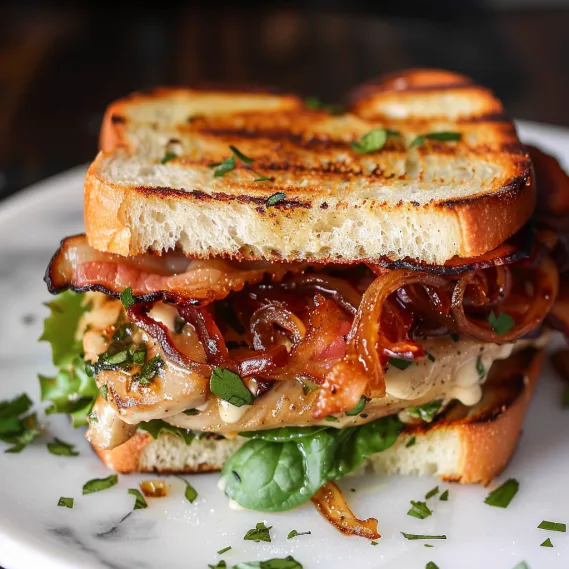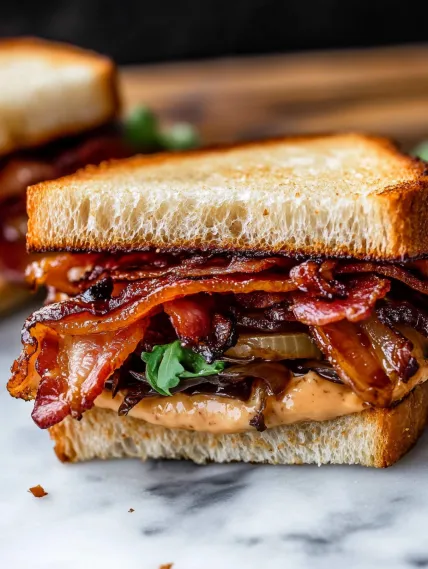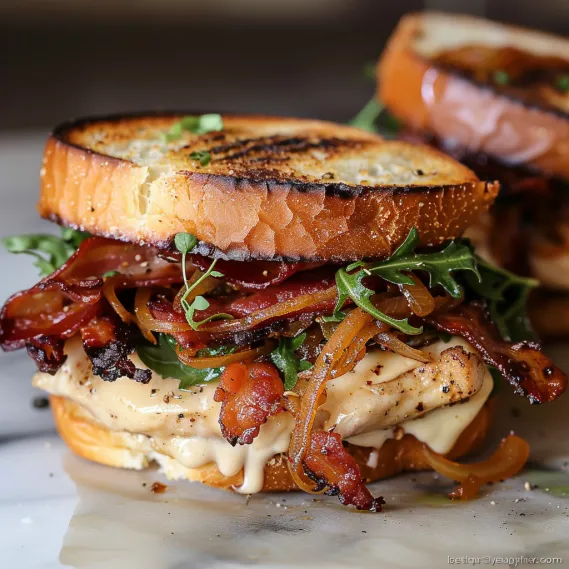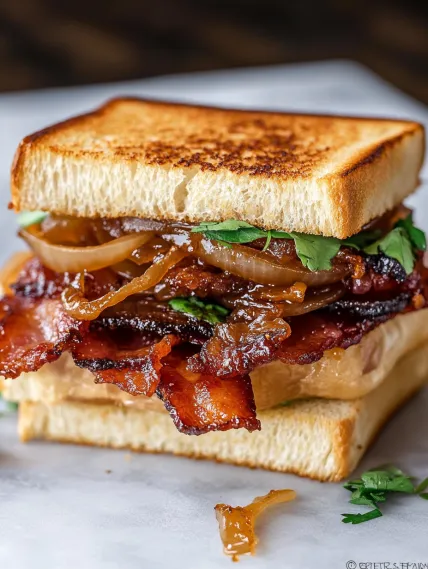 Pin it
Pin it
When it comes to comfort food, few things can beat the satisfaction of biting into a perfectly crafted bacon sandwich with caramelized onions. The crispy, savory bacon paired with the sweet, tender caramelized onions creates a harmonious symphony of flavors and textures that will leave your taste buds singing. I discovered this combination years ago at a tiny café while traveling, and I've been perfecting my version ever since. The secret lies in taking your time with those onions – rush them, and you'll miss out on their incredible depth of flavor.
Last weekend, I made these sandwiches when my in-laws stopped by unexpectedly. My father-in-law, who typically picks at his food, devoured his sandwich in record time and actually asked for another – something he's never done in the fifteen years I've known him. The combination of perfectly crisp bacon and meltingly sweet onions just has that effect on people.
Essential Ingredients and Selection Tips
- Thick-cut Bacon: Opt for quality bacon with good fat marbling. Cheaper varieties shrink too much and lack flavor. Applewood or hickory smoked adds wonderful depth.
- Yellow Onions: These caramelize beautifully. Look for firm onions with tight, papery skin. Sweet onions like Vidalia work too but will caramelize faster.
- Butter and Olive Oil: The combination prevents burning while adding richness. Use unsalted butter to control the saltiness.
- Bread: A sturdy sourdough or crusty artisan bread stands up best to the fillings. Toast it just enough to provide structure without becoming too crispy.
- Condiments: Real mayonnaise adds creaminess, while whole grain mustard provides a pleasant tang that cuts through the richness.
- Fresh Additions: Crisp lettuce and ripe tomato slices add freshness and texture contrast.
The first time I tried caramelizing onions, I cranked up the heat thinking it would save time. What a mistake! They burned quickly and tasted bitter rather than sweet. I've learned that patience truly is a virtue when it comes to coaxing out their natural sweetness.
Detailed Cooking Instructions
- Step 1: Caramelize Those Onions
- Start by thinly slicing 2 large yellow onions. Heat a heavy-bottomed skillet over medium-low heat, then add 1 tablespoon of butter and 2 tablespoons of olive oil. Once the butter melts, add your onions with a pinch of salt. The key here is low and slow – stir occasionally and let them cook for a full 25-30 minutes.
- Step 2: Perfect Your Bacon
- While the onions work their magic, prepare 8 slices of thick-cut bacon. For optimal results, start with a cold skillet and place bacon in a single layer. Cook over medium heat, turning frequently to ensure even crisping. If you prefer extra-crispy bacon, allow about 10 minutes total; for chewier bacon, about 7-8 minutes.
- Step 3: Prepare Your Bread
- Select 8 slices of quality bread – sourdough, ciabatta, or a hearty whole grain all work beautifully. Lightly toast the bread just until it's golden and firm enough to support your fillings without becoming too crunchy. If you're feeling indulgent, brush one side of each slice with reserved bacon drippings before toasting for an incredible flavor boost.
- Step 4: Layer With Care
- Spread your preferred condiments on the toasted bread. I find a thin layer of mayonnaise on one slice and whole grain mustard on the other creates the perfect flavor foundation. On one slice, arrange a generous portion of those caramelized onions – don't be shy here, they're the co-star of this show. Next, add 3-4 slices of bacon, breaking them if necessary to fit the bread.
- Step 5: The Final Touch
- Complete your masterpiece by adding the second slice of bread, press down gently, and slice diagonally if desired. This cut exposes all the beautiful layers you've built and makes the sandwich easier to eat. Allow the sandwich to rest for just a minute before serving – this brief pause lets the flavors meld together.
 Pin it
Pin it
My neighbor Mark, who swore he didn't like onions, tried this sandwich at our block party last summer. I caught him sneaking back for seconds, and later he admitted that he'd never had onions prepared properly before. Now he asks me for caramelizing tips whenever I see him. That's the magic of taking time with simple ingredients – they can completely change someone's perspective on food.
 Pin it
Pin it
The Art of Caramelization
The true heart of this sandwich lies in those perfectly caramelized onions. There's actual science behind the transformation – the slow cooking process breaks down the onions' natural sugars, creating hundreds of new flavor compounds. I've found that adding a splash of balsamic vinegar during the last five minutes of cooking adds depth and enhances the natural sweetness even further. My grandmother taught me to look for that distinctive mahogany color that signals they're done – a warm, rich brown but not black. When done properly, caramelized onions should taste intensely sweet with no hint of bitterness.
Beyond the Basic Sandwich
While the classic version is hard to beat, I've discovered several variations that have become favorites in my household. During summer months, I often add avocado slices and a drizzle of balsamic glaze for a refreshing twist. For weekend brunch, nothing beats adding a perfectly fried egg with a runny yolk that creates an instant "sauce" when you bite into it. My teenage son prefers his with melted sharp cheddar, which adds a wonderful tang that complements the sweet onions. The basic formula remains the same, but these small additions can customize the sandwich to suit any palate or occasion.
 Pin it
Pin it
I've been making this bacon sandwich with caramelized onions for over a decade now, and it never fails to impress. There's something magical about the combination of sweet, savory, and smoky flavors that satisfies on a primal level. What I love most is how such simple ingredients, when treated with care, can transform into something truly extraordinary. Whether I'm making it for a quiet lunch at home or serving it to guests, this sandwich represents what good cooking is all about – honoring ingredients and bringing people together through food.
Frequently Asked Questions
- → Can I use chicken thighs instead of chicken breasts?
- Yes, boneless skinless chicken thighs work beautifully in this recipe. They're naturally more tender and forgiving than chicken breasts. The cooking time may be similar, but always check that chicken thighs reach an internal temperature of 165°F (74°C). Thighs also bring a slightly richer flavor that pairs wonderfully with the creamy sauce.
- → What can I substitute for the white wine?
- If you prefer not to use wine, simply substitute with an equal amount of additional chicken broth. You can add 1 tablespoon of white wine vinegar or lemon juice to replace some of the acidity that the wine would provide. This will maintain the flavor balance without using alcohol.
- → Can I use frozen spinach instead of fresh?
- Yes, frozen spinach can be used as a substitute for fresh. Use about 1 cup of frozen spinach, thawed and with excess moisture squeezed out. Since frozen spinach is already wilted, you can simply stir it in at the end of the sauce preparation and heat through. This is a great option when fresh spinach isn't available.
- → What sides pair well with this dish?
- This creamy chicken pairs wonderfully with many sides. For starches, consider pasta (especially fettuccine or linguine), mashed potatoes, rice, or crusty bread to soak up the delicious sauce. For vegetables, roasted asparagus, sautéed green beans, or a simple side salad would complement it nicely. The dish is rich, so lighter sides often balance it well.
- → Can I make this dish ahead of time?
- Yes, this dish reheats well. You can prepare it up to 2 days in advance and store it in the refrigerator in an airtight container. Reheat gently on the stovetop over medium-low heat, adding a splash of chicken broth or cream if the sauce has thickened too much. The flavor often improves after the ingredients have had time to meld.
- → How can I make this recipe lighter?
- To create a lighter version, you can substitute the half and half with whole milk or evaporated milk. Reduce the amount of butter to 2 tablespoons, use light cream cheese, and cut the Parmesan to 1/2 cup. You could also increase the spinach to 4-5 cups for more vegetables. These changes will reduce the calories and fat while maintaining the creamy texture and flavor profile.
